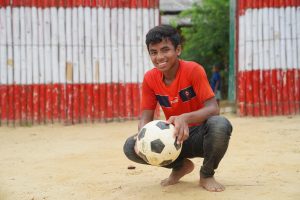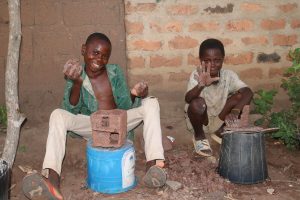World Refugee Day: Refugee children use hobbies to ease into new homes
In 2023, nearly 110 million people are displaced worldwide—forced from their homes by conflict, hunger, drought, and climate change. For World Refugee Day, Save the Children interviewed refugee children in Bangladesh, Nigeria, Peru, and Ukraine. These children have taken dangerous journeys to unfamiliar countries, seeking safety and hope. What many of them saw along the way was horrific—including dead bodies, extreme violence, and devastation caused by fighting, drought, and flooding. Some took these journeys with very little to eat, while others waded through rivers and hid for safety in forests.
World Refugee Day is a significant moment to raise awareness about the refugee crisis across the globe and highlight the stories of the millions of children who are living this reality every day. The day serves as a powerful reminder of the challenges faced by families who have been forced to flee their homes.
Now living in relative peace, many girls and boys who are refugees or internally displaced within their home countries are using hobbies to help them adapt to a new life. Meet some of these brave and resilient children below:
From Myanmar to Bangladesh

Cox’s Bazar in Bangladesh is home to the largest refugee settlement in the world, with almost one million Rohingya refugees, most of whom have now been living in the camps for close to six years.
Thirteen- year-old Tariqul* witnessed the unimaginable during the five-day journey to Bangladesh with his family in 2017. They saw dead bodies while walking through the jungle and only survived by eating tree leaves and drinking contaminated water. Now safe in Bangladesh, Tariqul sadly learned that his entire village had been burnt down after he left.
“I have witnessed destruction along the path of coming to this country. During those times, I would be terrified by the sound of gunfire. I have seen fire and heard distant explosions. At a very young age, I understood what war meant. This war had brought our entire family to a foreign land among unfamiliar people,” says Tariqul.
Tariqul visits a Save the Children youth centre every day after school, where he gets to play his favourite sport – football. “…. during football matches, I can forget all my sorrows and hardships,” he says.
From Cameroon to Nigeria

Clashes between armed groups in Cameroon have forced thousands of families to flee their homes, seeking refuge in neighbouring Nigeria. Eighty per cent are women and children.
In 2021, 12-year-old Martin* and his family travelled for a month to reach Nigeria from his village in Cameroon. His friend, 13-year-old Joseph*, spent three years in the forest in Cameroon with his family sheltering from armed groups. Now both boys are in a safe environment and have taken up sculpting as a hobby.
“Engaging in this hobby has also introduced me to new friends in the settlement. They continuously encourage me to excel in sculpting. Whenever I witness my friend Joseph* creating sculptures, it inspires me to join him and strive for greater heights,” says Martin
After school, Martin and Joseph attend a Save the Children program for children and youth where they can continue lessons. “I am particularly fond of the educational system in Nigeria because, unlike in Cameroon where I had to drop out of school for nearly five years, I have been given the opportunity to return to school here,” says Joseph.
From Venezuela to Peru

Nearly six million refugees from Venezuela live in countries across Latin America. Seven-year-old Victoria’s* mother, María*, was unable to feed, clothe and educate her daughter, so together they travelled from Venezuela to Peru in search of a better life. “I didn’t like the trip to Peru,” says Victoria. “We went from one bus to another; it was very hot. We went through rivers and trails.”
With cash assistance from Save the Children, María started a home beauty care business, giving her the opportunity to provide for her daughter. Victoria is also a great help to her mom’s business. “My mom does nails and braided hairstyles. I like to be with her and keep her company when she works because I spend more time with her. I help her by passing her things she forgets like cotton and nail files,” says Victoria.
From Ukraine to Poland

Since the conflict escalated in February last year, more than eight million people have fled Ukraine, the majority of them are women and children. Eleven-year-old Dima* and his 14-year-old sister Sofia* initially found it hard to adapt to their new life in Poland. For the first few months, both children were withdrawn, refused to eat, and found it hard to sleep. Once they enrolled in a Polish school, things got better.
“My school in Poland is the best. My classmates always respect me there. They understand that there is war in Ukraine. They are often helping me during classes, and a friend of mine from my class taught me how to speak Polish,” says Dima.

Back in Ukraine, Sofiia* spent five years learning how to play the piano. To help her adapt to her new life in Poland, Sofiia’s mother bought her a guitar using cash assistance from Save the Children so that she could continue her music education. Her love for the arts and music can now flourish and she is teaching herself how to play the guitar.
“I like metal and rock music, and I listen to Lil Peep, Nirvana – and I listen to Ukrainian music. I also draw, paint my nails and create sculptures from plasticine. I like to create characters, and to sculpt and draw them,” says Sofiia.
These are just some of the stories of child refugees from around the world who are adjusting to their lives in new countries. World Refugee Day provides a platform to promote understanding, empathy, and compassion towards refugees. It serves as a call to action for governments, organizations, and individuals to collaborate and find sustainable solutions to the refugee crisis, ensuring that every person forced to seek refuge can rebuild their lives with dignity and hope.
Read more about Save the Children’s programs that are improving the lives of children across the globe.
*names changed to protect privacy of children


